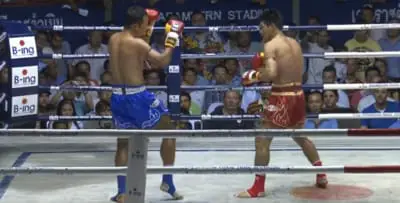
Both striking combat sports Muay Thai and boxing are very similar in a certain way. Actually Muay Thai fighters are often called “thai boxers”. But those two sports have huge differences and in this article, we’re going to take a closer look at them.
What is the difference between Muay Thai and boxing? The main difference is that n boxing you can only punch, while in Muay Thai besides punches you can also throw kicks, knees, and elbows. Muay Thai fighters also wear less equipment and Muay Thai fights are shorter than pro boxing fights.
| Boxing | Muay Thai | |
| Olympic Sport | Yes | No |
| Ways to win | • By Decision • Knockout • Technical knockout (when the ref stops the fight) | • By Decision • Knockout • Technical knockout |
| Equipment | • Gloves (8 – 10 oz depending on weight class) • Shorts • Boots • Hand wraps • Mouthpiece • Headgear (for amateur boxing) | • Gloves (8 – 10 oz) • Handwraps • Mouthpiece • Shorts • Traditional charm or inscribed cloth around their upper arm |
| Legal strikes | Only punches | • Punches • Kicks • Elbows • Knees |
| Time of Origin | 3rd millennium BC | 18th century |
| Match duration | 12 rounds 3 mins each (3-5 rounds for amateur boxing) | 5 rounds 3 minutes each |
| Rest between rounds | 1 minute | 2 minutes |
Muay Thai fighters don’t wear boots, and they have many more ways to knock their opponent out than boxers because of the variety of strikes they can throw.
But those are just the differences we can see at a first look. If you want to learn the specifics in fighting and scoring between those two great striking combat sports, continue reading.
Stance
Muay Thai
Since kicks are the rangiest and most powerful weapons, Muay Thai stance is designed to allow fighters to throw and defend kicks quickly and effectively. Feet are shoulder-width apart. The front foot is curved inward at about a 10-degree angle. Back foot curved out at about 45-degree angle. The body weight should be on the back foot. Muay Thai fighters step on the balls on their feet.
Boxing
Boxing stance is designed to give your maximum range for your punches, make you a small target and give you mobility in almost every direction. In boxing, your feet should be just a little wider than shoulder-width apart. Lead foot is curved in more than in Muay Thai (15-30 degrees).
Rear foot can be curved from 45 up to 90 degrees making your stance a little sideways. Front foot should be planted on the ground while rear foot heel should be lifted slightly off the ground. Weight can be distributed evenly between both legs or slightly on the front leg.
Kicking changes everything. When low kicks are allowed you need to be able to quickly bring your leg up and bend it to protect the thigh. That makes the attacker kick your shin or your knee which hurts and discourages them to kick your legs.
Defending high kicks and body kicks can be done by simply blocking with your hands but that’s not the case with leg kicks. And boxing stance doesn’t allow you to check kicks very well because it’s a little sideways.
And you can’t take much of those kicks in a fight. After a few leg kicks the damage accumulates making you immobile and imbalanced.
Leg kicks are the main reason why boxing and Muay Thai stances are so different.
Guard
Muay Thay
Muay Thai fighters use 2 types of guards – high guard and long guard.
When using high guard your hands should be 1-2 inches above your eyebrows and 3-4 inches forward. Your elbows are a little bit flared out (making your body open for kicks to bait your opponent). The high guard is used mostly by short fighters.
Long guard in Muay Thai is used by taller fighters with long hards. It’s when your lead arm is extended forward to keep a distance and parry punches while your rear hand is on your check protecting from blows.
Boxing
In boxing, there are many different guards used by different types of boxers. More aggressive boxers use the high guard or peekaboo guard (used by Mike Tyson) while defensive boxing who like to counter punch can use Philly Shell, or to keep the lead hand low (to bait punches to the head so they can counter).
Focusing only on punches helped boxers to find many different guards that can be used in different situations.
A big difference between boxing and Muay Thai guards is that boxers always keep their elbows tight, protecting their ribs and liver.
Pace and Attacks
Boxing
Boxing bouts have usually high pace (especially amateur boxing because it’s only 3-6 rounds).
Boxers also throw more combinations than Muay Thai fighters – some can be up to 10 punches. Boxers also start their combinations almost every time with a jab. It’s the quickest punch and they use it to measure the distance and set up combinations. Sometimes up to 50% of punches thrown in a boxing fight can just jabs.
Boxers punch the body much more than Muay Thai fighters.
When there’s a clinch in boxing, boxers try to place their head as close to their opponent as possible and hug is arms to avoid punches in the clinch. Clinching isn’t utilized offensively in boxing. It’s usually a defensive tactic used by hurt or tired boxer trying to stall.
Muay Thai
Muay Thai fights are slower-paced than boxing fights most of the time. In Thailand, there’s a tradition that the first round should start slow so people can place their bets on the fighter they think is going to win.
Muay Thay fighters usually stay in the center of the ring and trade kicks. They use the front kick to the body (teep) instead of a jab because it’s rangier and almost as quick as a jab.
Muay Thai fighters also attack the body but they usually do it with roundhouse kicks, teeps, and knees.
Clinching is Muay Thai an opportunity to land knees to the body (or head) and elbows to the head.
Footwork
Boxing
Boxers like to bounce on their feet a lot. They utilize in and out but also lateral movement when fighting. They like pivot, sidestep and even hop to take an advantageous angle towards their opponent from where they can punch without getting punched.
Boxers can fight moving back as effectively as moving forward. That’s why you can see fighters such as Floy Mayweather or Muhammad Ali pressed against the ropes during the fight but still winning.
Muay Thai
Footwork in Muay Thai is very limited. That’s because every time you move back you give up space and it’s hard to move back and kick. And every time you move to your left or right your step might be intercepted by a hard leg kick.
That’s why Muay Thai fighters are so static. They can occasionally do a sidestep to take a better angle for their body or head kicks but not much besides that.
Muay Thai fighters switch guards much more often than boxers though. Most boxers stay in the same guard (southpaw or orthodox) all the time during the fight. Muay Thai fighters occasionally switch guards to take advantage of different openings for their kicks.
Another big difference in footwork is that Muay Thai fighters don’t pivot their feet while punching. That’s because when pivoting and someone kicks your leg that can damage your knee or ankle seriously. Boxers pivot their feet when throwing every type of punch besides the jab which makes their punches more powerful than Muay Thai punches.
Defense
Muay Thai
When defending punches and kicks Muay Thai fighters prefer to block them, parry them or lean back. They also sometimes (instead of checking) retract heir lead leg back when their opponent tries to kick it.
Boxing
Boxing defense is more sophisticated. Boxers also block parry punches and occasionally lean back. But they also move back, utilize head movement (slipping and weaving) and sometimes use their shoulder to block punches to the head (as a shield).
Some of those defenses aren’t very effective in Muay Thai. For example, if you slip too many punches, eventually someone will intercept your head movement with a high kick which will be devastating.
Scoring
Muay Thai
Muay Thai is also scored round per round. The fighter who judges think to win the round gets 10 points and the fighter gets 9. If he won the round decisively his opponent can get 8 points and if he managed to drop him, his opponent may get only 7 points.
In Muay Thai judges (and fans) believe that you can’t strike effectively moving back. So it’s a good idea to not give up ground if you want to win.
Boxing
Boxing is also scored round per round by the 10 point system. But since in boxing, there are more rounds, single knockdowns aren’t that important.
For example, if you knock me down in the last 3 rounds but I won all other rounds (even without knocking you down) I’ll still win. Thinking knockdowns are very important is a common misconception a lot of fans have.
For instance, in the first Wilder vs Fury fight, I think Fury should’ve won because he won 10 of 12 rounds. He got dropped badly in 8 and 12 round but he outboxed Deontay Wilder in every other round.


